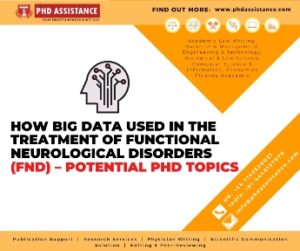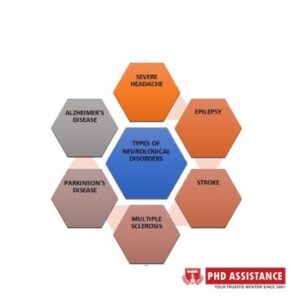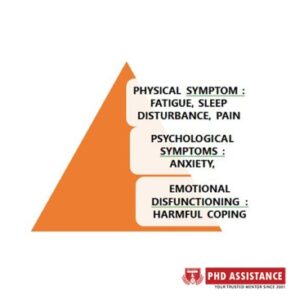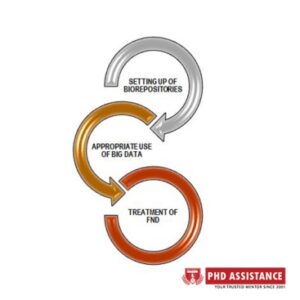How Big data used in the treatment of Functional Neurological Disorders (FND) – Potential PhD Topics
Introduction:
At the intersection of neurology and psychiatry, FND is a prevalent condition (Perez 2021). It is characterized by motor and sensory symptoms such as tremor, limb fatigue, dystonia, numbness, and seizures, and it was formerly known as conversion disorder. These symptoms are associated with severe distress and functional impairment and have clinical features that are incompatible with other neurological/medical diagnoses. Few controlled treatment trials and little research has been conducted till now to assess outcomes in FND. Due to the wide range of outcomes reported in patients with respect to a functional neurological disorder, the need to study these outcomes in detail has become essential (Pick 2020). Machine learning (ML) algorithms are being used widely to collect and analyze clinical neurological data. Algorithms like Random Forest, K-Nearest Neighbour (KNN), Support Vector Machine (SVM), multi-layer perception and Artificial Neural Network (ANN) have shown promising results and can be further used to fill the gap between outcome and treatment in FND patients.

Functional neurological disorder – Need for big data:
Despite being a common and disabling condition, FND has received little attention from the scientific community. Until recently, investigations involving the pathophysiology, aetiology and treatment of this condition were limited. However, this has begun to change over the last few years (Nicholson 2020). Researchers from the neurology and psychiatry community have conducted several research projects to study the outcome of FND and are continuing to do to improvise their understanding of this disorder by applying ML.

Fig. 1 : Types of neurological disorders
A variety of symptoms have been reported in FND patients, which complicates the prognosis and treatment of the condition. In people with FND, a wide range of physical, psychological symptoms along with potentially harmful coping behaviours and disease attitudes, and altered emotional functioning, lead to worse outcomes, and lower quality of life (Pick 2020). These symptoms contribute to the poor prognosis of FND, and, thus an extensive amount of research is required in this area.

Fig. 2 : Different symptoms associated with FND
Recent research:
Thanks to international collaborative programs and community activities, the field of functional neuroimaging had progressed significantly as BigData science in the last decade. Functional neuroimaging methods, such as functional magnetic resonance imaging (fMRI) acquired during the task (tfMRI) and resting-state (rsfMRI), magnetoencephalography (MEG), electroencephalography (EEG), and other modalities are important tools for studying the human brain. They also provide methodological foundations for quantitative cognitive neuroscience. This large-scale neuroimaging big data has been significantly supported by informatics infrastructure (Li 2019).

Fig. 3: Major components of big data and it’s application in treatment of functional neurological disorders (FND).
In the last ten years, patient groups and an international association, the functional neurological disorder society (FNDS), have emerged marking two significant milestones in the history of disorder. COMET (core outcome measures in effectiveness trials) has been initiated in Europe that includes development instructions and a searchable database of completed core outcome sets. In the United States, the National Institute of Neurological Disorders and Stroke (NINDS) is coordinating the development of a common data element (CDE) resource portal to address a variety of conditions such as epilepsy and traumatic brain injury (Nicholson 2020).
|
Disorder Name |
Problem Identification | Dataset | Algorithm | Solution | Reference |
| Seizures | To Detect & Predict Seizures In Patients | Freiburg & Children’s Hospital Boston-Massachusetts Institute Of Technology (Chb-Mit) Eeg Database | Random Forest, Support Vector Machine (SVM), Multi-Layer Perceptron(MLP) & K-Nearest Neighbour (KNN) | Best Results Were Obtained Using Svm : Accuarcy (99.7%) & Specificity (99.8%) |
[13] |
|
Parkinson’s Disease (Pd) |
Classification Of Pd From Healthy Controls (Hc) | 31 Patients : 8 Hc + 20 Parkinson’s Patient | Classification And Regression Tree (Cart), Svm, Artificial Neural Network (ANN) | Svm Accuracy = 93.84% | [5] |
| Strokes | To Detect & Classify Strokes | 420 Ct Images Of Patient’s Skulls | Mlp, Svm,Knn, Optimal Path Forest (Opf) & Bayesin Classifiers | Best Accuracy Was Shown By Opf (99.3%) | [14] |
| Alzheimers’s Disease | Diagnosis | Neuropsychological Tests Test Of 466 Patients | Naïve Bayes
Synthetic Minority Over-Sampling Technique (SMOTE) |
Obtained Data Was Further Evaluated On Different Platforms |
[3] |
Table 1: Application of ML in the treatment of different neurological disorders
For the early diagnosis of various neurological disorders, an intelligent diagnostic system has been proposed. The five layers of this framework include, data source, big data storage, data preprocessing, big data analytics and disease diagnosis. It aims to collect patient data via electronic medical records (EMRs), medical devices, IoT (internet of things) devices and research centers. This big data is then stored using different big data storage methods like, data warehouse, distributed platforms, multi-dimensional storage and cloud storage. Next, the preprocessing techniques are utilized to handle noise, missing values and remove outliers from the data. Big data analytics techniques (descriptive, predictive and perspective) are used analyze the data effectively. The obtained data is then used to conduct diagnostic analysis using ML algorithms (Kaur 2020).
Future Scope:
When it comes to the implementation and selection of optimal outcome measures, FND raises unique questions and challenges like – range of symptoms (polysymptomatic), lack of outcome measurement and incompetent prognosis and management techniques. These challenges can be possibly solved with the appropriate implementation of big data and ML. They may be useful in the diagnosis, prognosis and management of neurological disorders.
A diagnostic framework can be further developed and applied for better management of FND. The analysis of big data from medical and healthcare systems can be extremely useful in developing new healthcare strategies. The most recent technical advancements in data generation, processing, and analysis have boosted hopes for a personalized medicine revolution in the near future (Dash 2019). Big data and high-performance computing technologies can thus reshape the way we deliver healthcare and conduct research.
Reference:
- Alickovic, E., Kevric, L., and Subasi, A. (2018). Performance evaluation of empirical mode decomposition, discrete wavelet transform, and wavelet packed decomposition for automated epileptic seizure detection and prediction. Biomedical signal processing and control. 39, 94-102.
- Auger, S. D., Jacobs, B. M., Dobson, R., Marshall, C. R., & Noyce, A. J. (2021). Big data, machine learning and artificial intelligence: a neurologist’s guide. Practical neurology, 21(1),4-11.
- Bhagya Shree, S. R., and Sheshadri, H. S. (2018). Diagnosis of Alzheimer’s disease using naive Bayesian classifier. Neural computing and applications. 29(1), 123-132.
- Dash, S., Shakyawar, S. K., Sharma, M., & Kaushik, S. (2019). Big data in healthcare: management, analysis and future prospects. Journal of big data, 6(1), 1-25.
- Karapinar Senturk. (2020). Early diagnosis of parkinson’s disease using machine learning algorithms. Med hypotheses, 138, 109603-109603.
- Kaur, P., & Sharma, M. (2020). A smart and promising neurological disorder diagnostic system: An amalgamation og big data, IoT, and emerging computing techniques. Intelligent data analysis: from data gathering to data comprehension, 241-246.
- Lhatoo, S. D., Bernasconi, N., Blumcke, I., Braun, K., buchhalter, J., Denaxas, S., Galanopoulou, A., Josephson, C., Kobow, K., Lowenstein, D., Ryvlin, P., Schulze-Bonhage, A., sahoo, S. S., thom, M., Thurman, D., Worrell, G., Zhang, G. Q., & Wiebe, S. (2020). Big data in epilepsy: Clinical and research considerations. Report from the Epilepsy Big Data Task Force of the International League Against Epilepsy. Epilepsia, 61(9), 1869-1833.
- Li, X., Guo, N., & Li, Q. (2019). Functional neuroimaging in the new era of big data. Genomics, proteomics & bioinformatics, 17(4), 393-401.
- Nicholson, T. R., Carson, A., Edwards, M. J., Goldstein, L. H., Hallett, M. Mildon, B., Neilsen, G., Nicholson, C., Perez, D. L., Pick, S., Stone, J., and the FND-COM group, & FND0COM group collaborators are as follows (2020). Outcome measures for functional neurological disorder: A review of the theoretical complexities. The journal of neuropsychiatry and clinical neurosciences, 32(1), 33-42.
- Perez, D. L., Aybek, S., Poplirov, S., kozlowska, K., Stephen, C. D., Anderson, J., … & American Neuropsychiatric Association Committee for Research. (2021). A review and expert opinion on the neuropsychiatric assessment of motor functional neurological disorders. The journal of neuropsyciatry and clinical neurosciences, 33(1), 14-26.
- Pick, S., Anderson, D. G., Asadi-Pooya, A. A., Aybek, S., Baslet, G., Bloem, B. R., Bradley-Westguard, A., Brown, R. J., Carson, A. J., Chalder, T., Damianova, M., David, A. S., Edwards, M. J., Epstein, S. A., Espay, A. J., Garcin, B., Goldstein, L. H., Hallett, M., Jankovic, J., Joyce, E. M.,…. Nicholson, T. R. (2020). Outcome measurement in functional neurological disorder: a systematic review and recommendations. Journal of neurology, neurosurgery, and psychiatry, 91(6), 638-649.
- Reboucus Filhoa, P. P., Sarmentoa, R. M., Holandaa, G. B., and de Alencar Lima, D. (2017).A new approach to detect and classify stroke in skull CT images via analysis of brain tissue densities. Computer methods and programs in biomedicine. 148, 27-43.
- Alickovic, E., Ng, E. H. N., Fiedler, L., Santurette, S., Innes-Brown, H., & Graversen, C. (2021). Effects of hearing aid noise reduction on early and late cortical representations of competing talkers in noise. Frontiers in Neuroscience, 15.
- Dourado Jr, Carlos MJM, Suane Pires P. da Silva, Raul Victor M. da Nobrega, Antonio Carlos da S. Barros, Pedro P. Reboucas Filho, and Victor Hugo C. de Albuquerque. “Deep learning IoT system for online stroke detection in skull computed tomography images.” Computer Networks152 (2019): 25-39.



